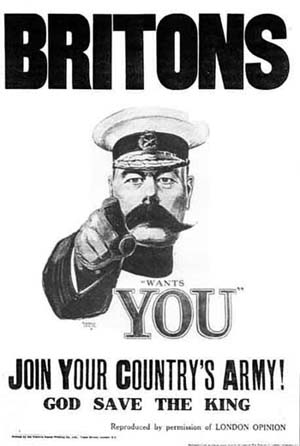Kitchener's Army
|
|
Following the outbreak of hostilities in the Great War the then British Secretary of State for War Horatio Kitchener, Lord Kitchener of Khartoum, advised forming a volunteer army of a million men. Officially called the "New Army" it was often referred to as Kitchener's Army.
Kitchener's Army represented a great turning point in the history of the United Kingdom: for the first time, the full effort of the nation and its people was committed to a massive land force fighting against other Great Powers on the Continent of Europe, with the Royal Navy playing an important but secondary role.
| Contents [hide] |
Origins
Contrary to general Cabinet belief that the war would be over by Christmas of 1914, Kitchener predicted a long and brutal war in which, if timed right, the arrival of an overwhelming force of new, well-trained and well-led divisions would prove a decisive blow against the Central Powers. Kitchener fought off all opposition to his plan, and all attempts to weaken or water down its potential, including a piece-meal dispersal of the regiments.
The New Army proved its worth in many ways and was sorely tested in the Battle of the Somme and the Battle of Passchendaele, where Field Marshal Douglas Haig used the troops in a costly attrition strategy which has caused no end of controversy.
Following the failure of the Ludendorff Offensive in the Spring of 1918 Kitchener's New Armies performed a combined arms counter attack which drove the German forces out of Belgium with enormous casualties. Many hundreds of thousands of German soldiers were captured or surrendered; this, coupled with a revolution in Germany, led their generals to request an armistice, which came into force at 11 o'clock on November 11, 1918.
Recruitment
All six of the full armies were made up of volunteer recruits, which included the famous Pals' Battalions. Due to the huge numbers of men wishing to sign up, in places queues up to a mile long formed outside recruitment offices. There were many problems in equipping and providing shelter for them. Rapidly the Government added many new recruitment centres which eased the admissions burden and began a program of temporary construction at the main training camps.
Training
In theory a recruit who was accepted into the army was first sent to his Regimental depot, where he would receive his kit and be given an introduction to army discipline and training, before being sent to the main training camps to join his battalion. In practice, no Regiment had the required stocks of equipment, or the manpower to train the flood of recruits, men were trained in their own clothes and shoes. In order to mitigate this problem, old stored uniforms, including 1st Boer War vintage red jackets, were issued. Some Regiments bought their own uniform and boots with money paid from public collections. Many Regiments were also issued with emergency blue uniforms, popularly known as Kitchener Blue.
10th_(Irish)_Division_at_Basingstoke.jpg
In order for the soldiers to be able to show which unit they belonged to whilst this crisis went on, they wore regimental and unit badges or patches on their clothing. Many photographs from the era show uniformed soldiers drilling alongside civilian clothed soldiers, perhaps led by red jacketed NCOs. The Regiments also suffered from a lack of officers to train them and the government called up all reserve list officers and any British Indian Army officer who happened to be on leave in the UK during the period. More new officers were created, when their commanding officers were encouraged to promote them from the ranks.
Weapons also proved to be a problem, no artillery pieces had been left in Britain to train new artillery battalions, and most regiments had to drill with obsolete rifles or wooden mockups.
By early 1915 many of these problems had been overcome, in one way or another, including pressing into use old ceremonial cannons and unfinished modern artillery pieces (they lacked targeting sights) and as 1915 progressed even these shortages were made good.
Structure
Kitchener's New Army was made up of the following Army Groups and Divisions:
- K1 Army Group
- 9th (Scottish) Division
- 10th (Irish) Division
- 11th (Northern) Division
- 12th (Eastern) Division
- 13th (Western) Division
- 14th (Light) Division
- K2 Army Group
- 15th (Scottish) Division
- 16th (Irish) Division
- 17th (Northern) Division
- 18th (Eastern) Division
- 19th (Western) Division
- 20th (Light) Division
- K3 Army Group
- K4 Army Group
Broken up into reserve regiments.
- K5 Army Group
Redesignated K4 following break up of original K4.
- K6 Army Group
Redesignated K5 following redesignation of original K5.
- 36th (Ulster) Division
- 37th Division
- 38th (Welsh) Division
- 39th Division
- 40th Division
- 41st Division
See also
- British military history
- UK topics
- Kitchener's Army divisional structure 1915
- Kitchener's Army divisional structure 1918
- List of British divisions in WWI
External Links
- E-book (http://www.gutenberg.org/etext/12877) The First Hundred Thousand by John Hay Beith at Project Gutenberg
- E-book (http://www.gutenberg.org/etext/12302) All in It: K(1) Carries On A Continuation of the First Hundred Thousand by John Hay Beith at Project Gutenbergnl:Kitchener's army

